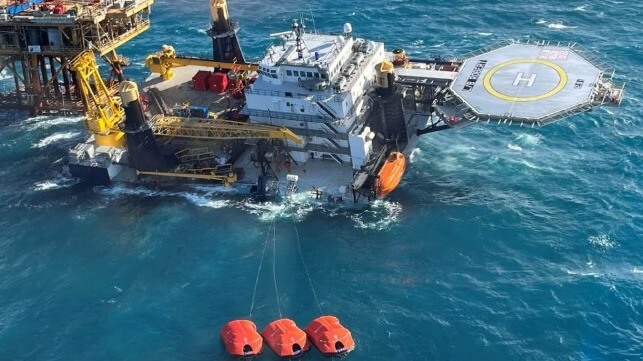NTSB: High Waves Tipped Over Liftboat off Louisiana

The NTSB has concluded its investigation into a tilt-over incident involving the Louisiana-based liftboat Robert in 2022, and has concluded that high waves reached the bottom of the ship's hull while it was elevated, nudging one of its legs into an adjacent low spot in the seabed.
On September 23, 2022, the Robert was operating about 80 miles to the southeast of Lake Charles, Louisiana, alongside an Apache Corp.-owned oil production platform. The Robert was chartered to support a plug-and-abandonment campaign on several wells connected to the platform.
To jack up and prepare for work alongside the platform, the Robert would lower its legs. But before it took that step, the operator mapped the seabed around the platform to look for hazards, like can holes - the depressions in the mud left by previous liftboat operators. The Robert's captain, the company's VP of operations and an operations manager all looked at the third-party survey map to find the best place for Robert to set up.
They settled on the east side of the platform, and the crew of the Robert jacked up the legs until the vessel was just clear of the waves. As an extra precautionary measure, the shoreside management had the crew take on extra ballast as a preload for an extended period of 36 hours. One leg was 25 feet away from a can hole, which was far enough to meet company standards but still relatively close by. However, the operation was interrupted by approaching foul weather. A hurricane was on the way into the area, so the crew jacked down again, refloated their vessel and transited 18 hours away to the northwest.
On October 3, they returned to the platform and selected a new site to jack up. After finding the best spot, they lowered their legs and raised the Robert about 48 feet above the water.
The Robert stayed on scene working for weeks. On November 15, the forecast turned, and the captain grew concerned about approaching weather. The surface conditions for Nov. 19-20 looked poor, with predicted maximum wave height exceeding 20 feet.
Robert was rated for waves of 15 feet or less when it was jacked up in deeper water. However, it was only rated for waves of 8 feet or less when under way. In the calm waters of the Gulf of Mexico this was usually sufficient, but this time it created a challenge. Given how long it would take to jack down the Robert and pull its legs out of the mud, and the vessel's four-knot operating speed, the captain believed that he would not be able to outrun the storm before surface waves were higher than the vessel's underway operating limit.
On November 17, as a precautionary measure, the company decided to fully evacuate the Robert. All of the construction crew departed by helicopter that day, and the vessel's crew spent the next day preparing for heavy weather. They lowered the ship to 25 feet above the water, left one generator running and boarded a helicopter to fly to shore on the 18th.
By the 19th, nearby weather stations were recording sustained storm force winds. Significant wave heights were likely in the range of 12-15 feet, suggesting peak heights of 24-30 feet. This would have been enough to exceed the air gap that the crew left between the vessel and the water's surface.
On the morning of the 20th, the Robert slowly began tipping (or listing, depending on the definition). At 1300 hours, a helicopter aircrew flew overhead and noticed a pronounced lean (or list) to port. The port side deck edge was in the water, and three liferafts had inflated themselves and floated free. Photos from the scene show that the vessel was subjected to heavy wave action after the port side reached the water.
On November 23, after the weather had improved, a crew of salvors and company personnel returned to the Robert to inspect the damage. The captain assessed that the vessel had shifted 19 feet to port. The generator was still running, but the main engine's cooling water system was inoperable. The starboard thruster room had a small leak through a crack in the hull and was taking on water.
Over the course of two weeks, the response team righted the vessel, jacked up its legs and rigged up a tow. The Robert arrived safely back at the port of Amelia, Louisiana in early December.

that matters most
Get the latest maritime news delivered to your inbox daily.
The damage to the rig was considerable. Equipment and cargo had shifted on deck; the vessel's structure had sustained stress fractures in multiple locations; the three legs had bent slightly within the leg towers; and the jacking equipment was damaged. The total cost of repair was estimated at about $7 million.
NTSB assessed that the stress of wind and waves on the vessel was transferred down the legs to the seabed, where the liftboat's pads were embedded in the mud. As the force increased, the seabed under the port side pad likely crumbled and shifted into the nearby can hole, and the leg likely slid with it, NTSB determined.
